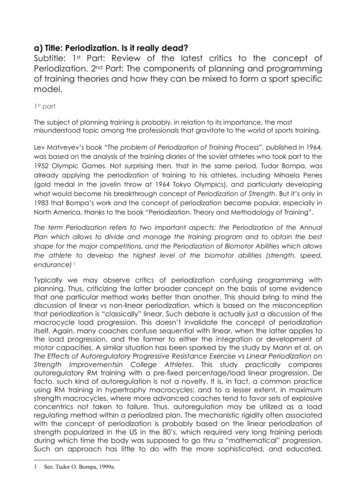
Transcription
a) Title: Periodization. Is it really dead?Subtitle: 1st Part: Review of the latest critics to the concept ofPeriodization. 2nd Part: The components of planning and programmingof training theories and how they can be mixed to form a sport specificmodel.1st partThe subject of planning training is probably, in relation to its importance, the mostmisunderstood topic among the professionals that gravitate to the world of sports training.Lev Matveyev’s book “The problem of Periodization of Training Process”, published in 1964,was based on the analysis of the training diaries of the soviet athletes who took part to the1952 Olympic Games. Not surprising then, that in the same period, Tudor Bompa, wasalready applying the periodization of training to his athletes, including Mihaela Penes(gold medal in the javelin throw at 1964 Tokyo Olympics), and particularly developingwhat would become his breakthrough concept of Periodization of Strength. But it’s only in1983 that Bompa’s work and the concept of periodization became popular, especially inNorth America, thanks to the book “Periodization. Theory and Methodology of Training”.The term Periodization refers to two important aspects: the Periodization of the AnnualPlan which allows to divide and manage the training program and to obtain the bestshape for the major competitions, and the Periodization of Biomotor Abilities which allowsthe athlete to develop the highest level of the biomotor abilities (strength, speed,endurance) 1Typically we may observe critics of periodization confusing programming withplanning. Thus, criticizing the latter broader concept on the basis of some evidencethat one particular method works better than another. This should bring to mind thediscussion of linear vs non-linear periodization, which is based on the misconceptionthat periodization is “classically” linear. Such debate is actually just a discussion of themacrocycle load progression. This doesn’t invalidate the concept of periodizationitself. Again, many coaches confuse sequential with linear, when the latter applies tothe load progression, and the former to either the integration or development ofmotor capacities. A similar situation has been sparked by the study by Mann et al. onThe Effects of Autoregulatory Progressive Resistance Exercise vs Linear Periodization onStrength Improvementsin College Athletes. This study practically comparesautoregulatory RM training with a pre-fixed percentage/load linear progression. Defacto, such kind of autoregulation is not a novelty. It is, in fact, a common practiceusing RM training in hypertrophy macrocycles; and to a lesser extent, in maximumstrength macrocycles, where more advanced coaches tend to favor sets of explosiveconcentrics not taken to failure. Thus, autoregulation may be utilized as a loadregulating method within a periodized plan. The mechanistic rigidity often associatedwith the concept of periodization is probably based on the linear periodization ofstrength popularized in the US in the 80’s, which required very long training periodsduring which time the body was supposed to go thru a “mathematical” progression.Such an approach has little to do with the more sophisticated, and educated,1See. Tudor O. Bompa, 1999a.
periodized strategies of the best coaches who base the load determination on acontinuous feed-forward/feedback/adjustment process, as it should be.In recent years it has become a common thought among some strength and conditioningcoaches in team sports that periodization is an impracticable way of planning andprogramming for team sports, and therefore not practiced. This is due to the fact thatperiodization, historically, was born as a methodological mean for individual sports,characterized by very few competitions and therefore by a very long preparatory period,with the goal of reaching peak performance in one or more well defined moment of theseason. These features, long preparatory phase and short competition phase, are missingin some team sports, especially after the advent of professionalism and very longcompetitive phases. The above mentioned definition of periodization shows that any planthat divides the year into periods meets one of its two main characteristics. What wouldchange in a sport with a long competitive phase with frequent competitions should be theperiodization of biomotor abilities and the ratio between general and specific work.2nd PartAs we can see in the following image the concept of periodization is rather wide as itincludes many theoretical and methodological concepts.
In this image we have listed the smallest components of every theory on planning thetraining process.In fact, before we discuss which planning and programming method is better suitedfor a certain situation, we should agree on the terminology; and even more important,the very concepts that form the theory of planning and programming of training.Planning and ProgrammingFirst, let’s define planning and programming. Planning may be defined as the longand mid-term strategy that regulates the training process, i.e. the structure withinwhich the training process will take place. Programming, on the other hand, is the actof filling said structure with actual content, i.e. the actual training modalities.Periodization of TrainingAs Prof. Tudor Bompa writes, periodization refers to two important aspects of planningandprogramming the training:a) The Periodization of the Annual Plan which, by dividing the year into smaller trainingphases, makes it easier to manage the training and peaking processes.b) The Periodization of the Conditional Motor Capacities (aka biomotor abilities),whichenables one to develop the motor capacities: strength, speed and endurance to anoptimallevel for sport performance.Given what has been just stated, each time we have a division of the year into smallerphases and a sequence of development for each conditional motor capacity, wehave a periodized plan. Some critics of periodization state that it was born forindividual sports that include a long preparation phase and a short competitivephase. Thus, it would not be applicable to modern team sports; which have a shortpreparation period and a very long competitive period. This would only be true if onecombination of all the factors were possible. In reality, however, we may design as
many periodized plans as necessary; relative to the possible situations we mayencounter in the sport training process.Furthermore, if we were to analyze what these coaches actually do, their plans wouldstill entail a division of the year into smaller periods and a periodization of conditionalmotor capacities; thereby, satisfying the requirements to define those schemes as“periodized plans”.Periodization of the Annual PlanThe annual plan periodization is based on fundamental concepts such as:a) Sport performance improvement is based, especially for the high level athlete, on theincrease of the athlete's motor potential.b) Morpho-functional adaptations require some time, as well as an alternation of workand recovery, to manifest themselves.c) The development of the conditional motor capacities and the improvement of thetechnical and tactical aspects require a progressive approach where training stimuliintensity is gradually increased, on the basis of previously induced morphological and\orfunctional adaptations.d) The athlete cannot maintain peak performance for a prolonged or undefined time.2Bompa’s terminology differs from that of the Soviets, who speak of microcycle, mesocycleand macrocycle, the latter of various time length: six-months, annual, four years (Olympiccycle). Our concepts imply the following terminology:Annual Plan - (annual macrocycle for the Soviets): Division of the year in phases,subphases, macrocylces and microcycles, to better manage the training process.Phases - (macrocycles for the Soviets): Preparation, competition, transition.Subphases – Further definition of the content of the phases, named as: GeneralPreparation, Specific Preparation, Precompetitive Competitive and Transition. Groups ofmacrocylces with the same training direction, and whose length can vary from one week(a short transition phase) to twenty-four weeks (a long General Preparation Phase) .Macrocycle - (mesocycle for the Soviets): Group of microcycles with the same trainingdirection (according to the macrocycle and sub-phase), whose length can vary from two(a pre-competitive unload macrocycle, called taper) to six weeks (a long introductorymacrocycle in General Preparation), generally three or four weeks long.Microcycle - Cyclic sequence of training units that follow the macrocycle goals, whoselength vary from five to fourteen days, usually a week.2See. Yurij L.V. Verkhoshanskij, 2008.
Training Unit - It is the single training session with intra-pauses shorter than 45 minutes.Annual plans are characterized by the number of competitive phases, and defined asmonocyclical, bi-cyclical and tri-cyclal based on such characteristic.Periodization of the Conditional Motor CapacitiesMuch more important is to describe the concepts related to the periodization ofconditional motorcapacities. The four elements that differentiate each theory and methodology ofplanning andprogramming of training, in reference to the periodization of strength, speed andendurance, are:1) Integration of the conditional motor capacities2) Development of each conditional motor capacity throughout the plan3) Degree of specificity of the training means throughout the plan4) Load progressionIntegration
The integration of the conditional motor capacities refers to the way each motorcapacity is trainedin the annual plan; in relation to the others. We can have two strategies:a) Complex: strength, speed and endurance are all trained at the same time.b) Sequential: strength, speed and endurance are emphasized at different timesduring theannual plan (concentrated loading). In such kind of plans, usually it’s strength that isseparated from the development of speed (for example, Verkhoshansky’s strengthblock).DevelopmentThe concept of development of a conditional motor capacity refers to the way eachconditionalmotor capacity is trained during the annual plan. We can have three differentapproaches:1) Complex, all the qualities of a conditional motor capacity are trainedsimultaneously (forexample maximum strength, speed strength and muscular endurance). This canhappen atdifferent levels:a) Training Unit; maximum strength, speed strength and muscular endurance aretrained withthis sequence within the single training unit.b) Microcycle; maximum strength, speed strength and muscular endurance are alltrained in themicrocycle, in different training units.c) Macrocycle; maximum strength, speed strength and muscular endurance aretrainedthroughout the macrocycle, during dedicated microcycles.2) Sequential, the qualities of a conditional motor capacity are trained sequentially(forexample anatomical adaptation followed by maximum strength followed by power).The loading parameters for the sequential approach can be manipulated in such away to haveeither:a) An immediate realization; at the end of the macrocycle, the indexes of the trainedconditional motor capacity quality are improved.b) A delayed realization; at the end of the macrocycle, the indexes of the trainedconditionalmotor capacity quality are depressed but improve later on (aka plannedoverreaching).3) Pendular, two qualities of a conditional motor capacity are trained in alternativefashion(for example maximum strength followed by power followed by maximum strengthfollowed by power).Specificity of the Training MeansAgain, we can have two different approaches for the use of specific trainingmeans. Allow me to provide you with an example of what happens in the world of
football (soccer) training. For instance, in some third world countries, the number ofteams is small and the competitive season is short. Thus the preparation period islonger than what we have in Europe. During their general preparation, the trainingis much more concentrated on the improvement of the conditional motorcapacities than on the use of specific means (the ball) and loading parameters.On the other hand, in Europe, players use the ball (specific training mean) fromday one of the relatively short preparation period (in which the training ofconditional motor capacities still dominates) and might play the first friendly gameafter only 5-7 days of preparation (specific loading parameter).For the sake of terminology consistency, I have called such approaches sequential(when the use of general training means precede the use of specific trainingmeans) and complex (when general and specific training means are usedsimultaneously).Load ProgressionLinear loading has been proven, both scientifically and empirically, to be aninferior way of applying progressive overload. In fact, it’s very unlikely that abiological system progresses in a mechanical/mathematical fashion over time. Acyclic, undulating and self-adjusting model is certainly more adequate to elicitcontinuous and positive morpho-functional adaptations. Such characteristics can,or better yet, should be taken into consideration when designing a periodizedplan. The undulation can take place at the macrocycle and microcycle level. Themacrocycle can be undulated by alternating microcycles of different load(Column 1, macrocycle sometime used by Cuban weightlifters, and 2) or byplacing a deload microcycle at the end of it (Column 3, typical generalpreparation macrocycle set-up – Step loading / Column 4, typical specificpreparation macrocycle set-up, Flat loading).
The undulation of the load within the microcycle follows the very importantmethodological concepts of energy systems and load alternation. In the case ofcompetitive microcycles, the need for post-competition recovery and precompetition deloading should also be taken into consideration.The self-adjusting characteristic is obta
Periodization of Training As Prof. Tudor Bompa writes, periodization refers to two important aspects of planning and programming the training: a) The Periodization of the Annual Plan which, by dividing the year into smaller training phases, makes it easier to manage the training and peaking processes.


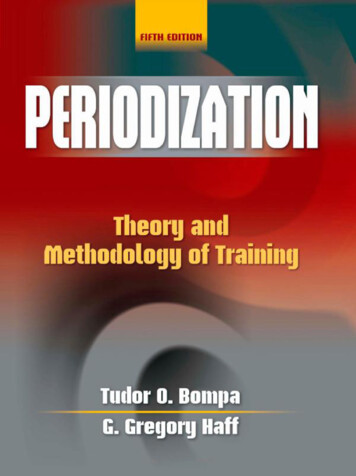
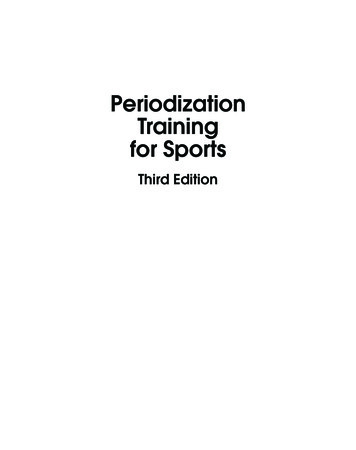
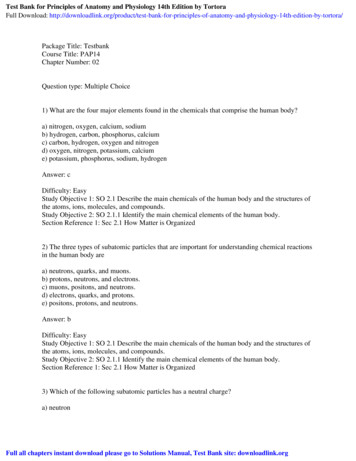


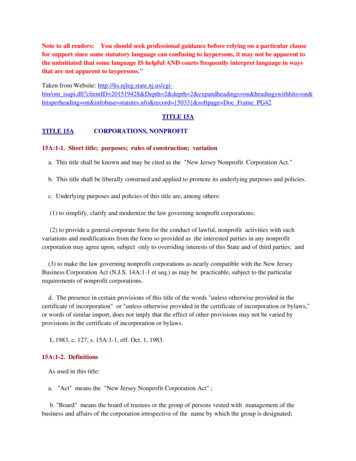
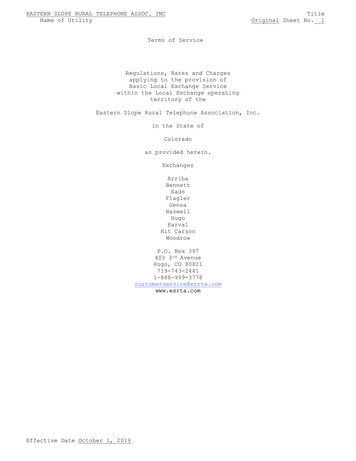
![Last or Business First [Maiden] Page Title Notes](/img/1/saukcity125thjubilee-20historical-20album-index.jpg)
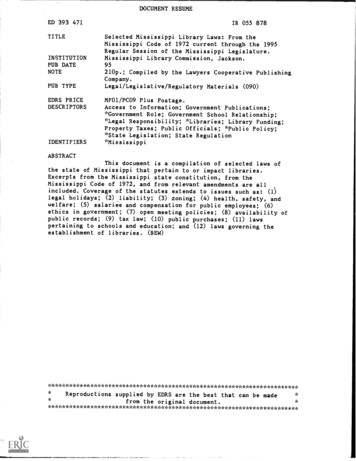
![[Code of Federal Regulations] [Title 21, Volume 8 .](/img/2/21-cfr-part-820.jpg)